Purchasing Management: Supplier Selection and ICT at Apple Inc.
VerifiedAdded on 2019/10/30
|11
|2857
|55
Report
AI Summary
This report analyzes purchasing management practices, specifically focusing on Apple Inc. It begins with an introduction to purchasing management and its importance, followed by an examination of supplier selection criteria, emphasizing factors like reliability, cost, and service. The report then explores the application of Information Communication Technology (ICT) in streamlining purchasing operations, highlighting the use of emails, video conferencing, and instant messaging to improve communication and efficiency. Furthermore, the report delves into purchasing cost analysis, recommending tools such as competitive bid comparisons, prior quotation comparisons, and price list comparisons. The analysis also considers legally mandated prices and the comparison of similar items to determine the most cost-effective purchasing strategies. The report underscores the significance of strategic approaches to achieve cost leadership, foster growth, and establish a sustainable advantage in the procurement process.
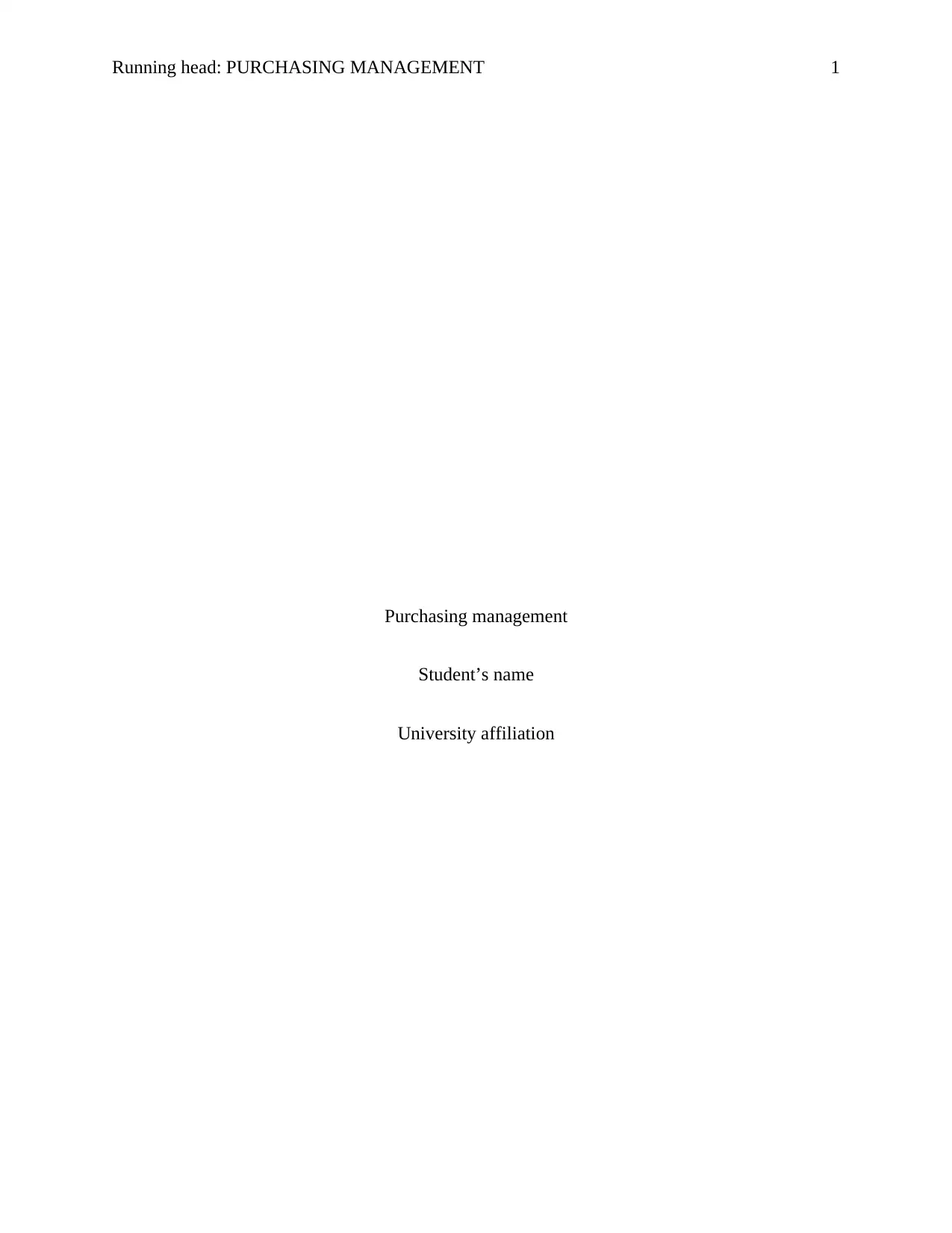
Running head: PURCHASING MANAGEMENT 1
Purchasing management
Student’s name
University affiliation
Purchasing management
Student’s name
University affiliation
Paraphrase This Document
Need a fresh take? Get an instant paraphrase of this document with our AI Paraphraser
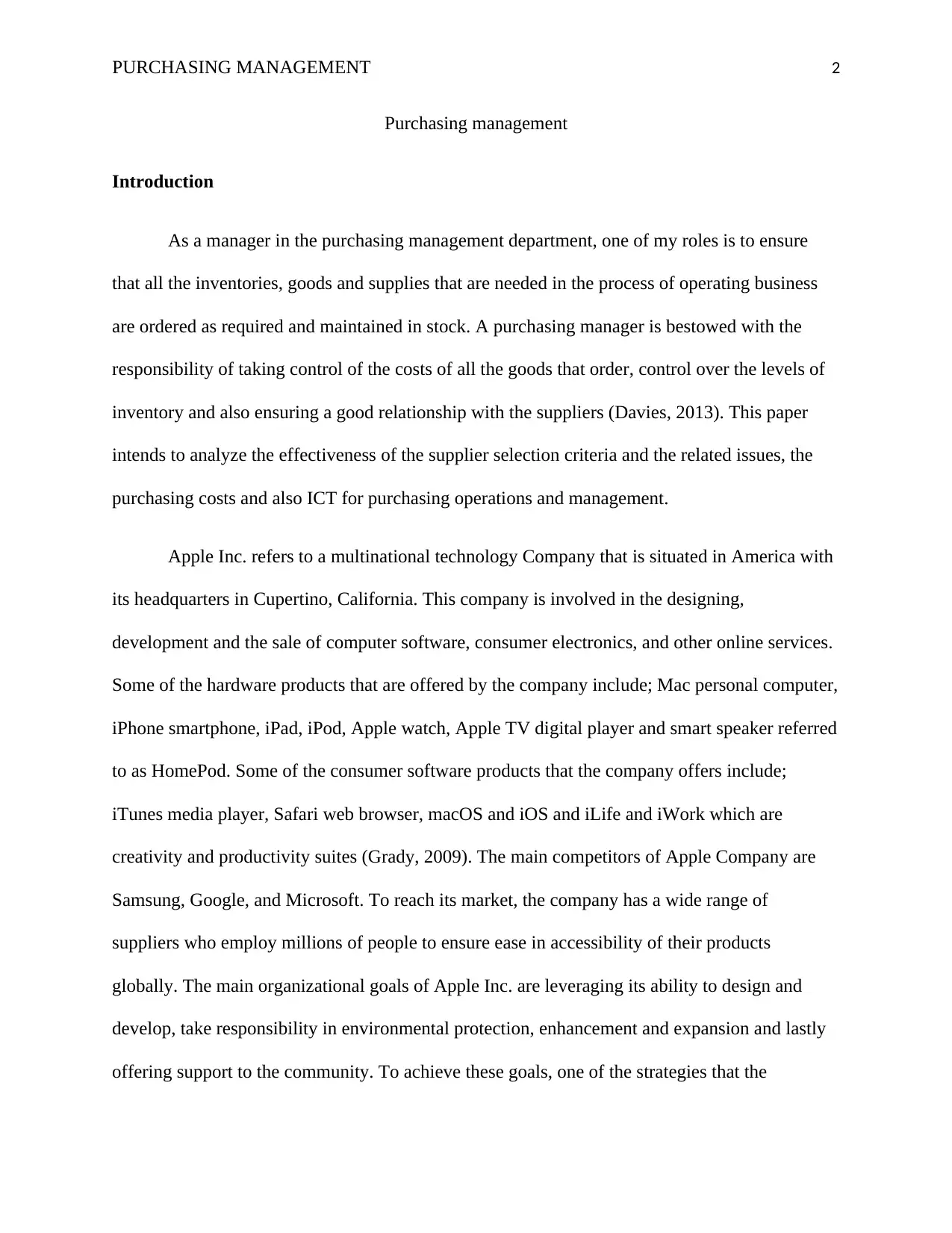
PURCHASING MANAGEMENT 2
Purchasing management
Introduction
As a manager in the purchasing management department, one of my roles is to ensure
that all the inventories, goods and supplies that are needed in the process of operating business
are ordered as required and maintained in stock. A purchasing manager is bestowed with the
responsibility of taking control of the costs of all the goods that order, control over the levels of
inventory and also ensuring a good relationship with the suppliers (Davies, 2013). This paper
intends to analyze the effectiveness of the supplier selection criteria and the related issues, the
purchasing costs and also ICT for purchasing operations and management.
Apple Inc. refers to a multinational technology Company that is situated in America with
its headquarters in Cupertino, California. This company is involved in the designing,
development and the sale of computer software, consumer electronics, and other online services.
Some of the hardware products that are offered by the company include; Mac personal computer,
iPhone smartphone, iPad, iPod, Apple watch, Apple TV digital player and smart speaker referred
to as HomePod. Some of the consumer software products that the company offers include;
iTunes media player, Safari web browser, macOS and iOS and iLife and iWork which are
creativity and productivity suites (Grady, 2009). The main competitors of Apple Company are
Samsung, Google, and Microsoft. To reach its market, the company has a wide range of
suppliers who employ millions of people to ensure ease in accessibility of their products
globally. The main organizational goals of Apple Inc. are leveraging its ability to design and
develop, take responsibility in environmental protection, enhancement and expansion and lastly
offering support to the community. To achieve these goals, one of the strategies that the
Purchasing management
Introduction
As a manager in the purchasing management department, one of my roles is to ensure
that all the inventories, goods and supplies that are needed in the process of operating business
are ordered as required and maintained in stock. A purchasing manager is bestowed with the
responsibility of taking control of the costs of all the goods that order, control over the levels of
inventory and also ensuring a good relationship with the suppliers (Davies, 2013). This paper
intends to analyze the effectiveness of the supplier selection criteria and the related issues, the
purchasing costs and also ICT for purchasing operations and management.
Apple Inc. refers to a multinational technology Company that is situated in America with
its headquarters in Cupertino, California. This company is involved in the designing,
development and the sale of computer software, consumer electronics, and other online services.
Some of the hardware products that are offered by the company include; Mac personal computer,
iPhone smartphone, iPad, iPod, Apple watch, Apple TV digital player and smart speaker referred
to as HomePod. Some of the consumer software products that the company offers include;
iTunes media player, Safari web browser, macOS and iOS and iLife and iWork which are
creativity and productivity suites (Grady, 2009). The main competitors of Apple Company are
Samsung, Google, and Microsoft. To reach its market, the company has a wide range of
suppliers who employ millions of people to ensure ease in accessibility of their products
globally. The main organizational goals of Apple Inc. are leveraging its ability to design and
develop, take responsibility in environmental protection, enhancement and expansion and lastly
offering support to the community. To achieve these goals, one of the strategies that the
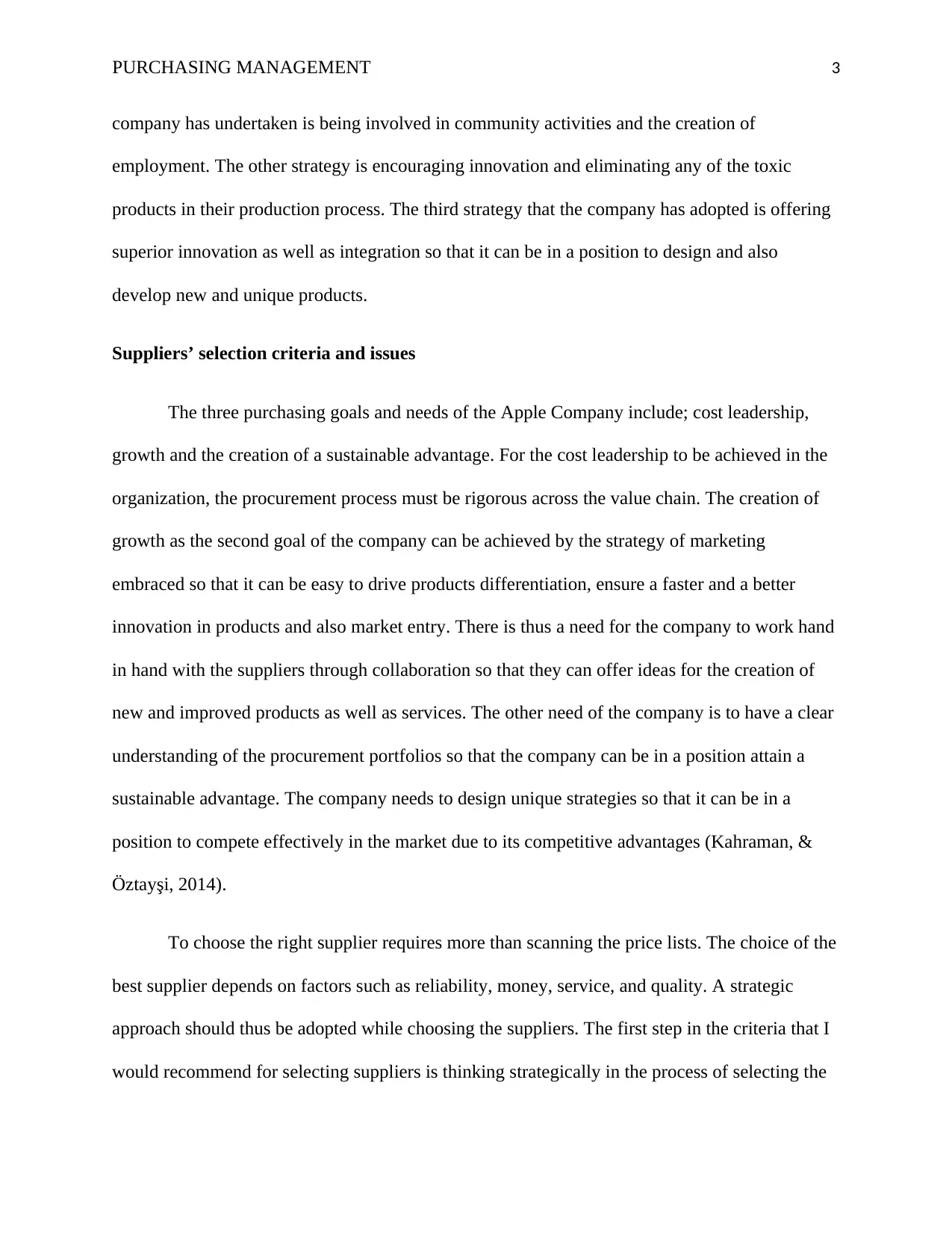
PURCHASING MANAGEMENT 3
company has undertaken is being involved in community activities and the creation of
employment. The other strategy is encouraging innovation and eliminating any of the toxic
products in their production process. The third strategy that the company has adopted is offering
superior innovation as well as integration so that it can be in a position to design and also
develop new and unique products.
Suppliers’ selection criteria and issues
The three purchasing goals and needs of the Apple Company include; cost leadership,
growth and the creation of a sustainable advantage. For the cost leadership to be achieved in the
organization, the procurement process must be rigorous across the value chain. The creation of
growth as the second goal of the company can be achieved by the strategy of marketing
embraced so that it can be easy to drive products differentiation, ensure a faster and a better
innovation in products and also market entry. There is thus a need for the company to work hand
in hand with the suppliers through collaboration so that they can offer ideas for the creation of
new and improved products as well as services. The other need of the company is to have a clear
understanding of the procurement portfolios so that the company can be in a position attain a
sustainable advantage. The company needs to design unique strategies so that it can be in a
position to compete effectively in the market due to its competitive advantages (Kahraman, & Ö
ztayşi, 2014).
To choose the right supplier requires more than scanning the price lists. The choice of the
best supplier depends on factors such as reliability, money, service, and quality. A strategic
approach should thus be adopted while choosing the suppliers. The first step in the criteria that I
would recommend for selecting suppliers is thinking strategically in the process of selecting the
company has undertaken is being involved in community activities and the creation of
employment. The other strategy is encouraging innovation and eliminating any of the toxic
products in their production process. The third strategy that the company has adopted is offering
superior innovation as well as integration so that it can be in a position to design and also
develop new and unique products.
Suppliers’ selection criteria and issues
The three purchasing goals and needs of the Apple Company include; cost leadership,
growth and the creation of a sustainable advantage. For the cost leadership to be achieved in the
organization, the procurement process must be rigorous across the value chain. The creation of
growth as the second goal of the company can be achieved by the strategy of marketing
embraced so that it can be easy to drive products differentiation, ensure a faster and a better
innovation in products and also market entry. There is thus a need for the company to work hand
in hand with the suppliers through collaboration so that they can offer ideas for the creation of
new and improved products as well as services. The other need of the company is to have a clear
understanding of the procurement portfolios so that the company can be in a position attain a
sustainable advantage. The company needs to design unique strategies so that it can be in a
position to compete effectively in the market due to its competitive advantages (Kahraman, & Ö
ztayşi, 2014).
To choose the right supplier requires more than scanning the price lists. The choice of the
best supplier depends on factors such as reliability, money, service, and quality. A strategic
approach should thus be adopted while choosing the suppliers. The first step in the criteria that I
would recommend for selecting suppliers is thinking strategically in the process of selecting the
⊘ This is a preview!⊘
Do you want full access?
Subscribe today to unlock all pages.

Trusted by 1+ million students worldwide
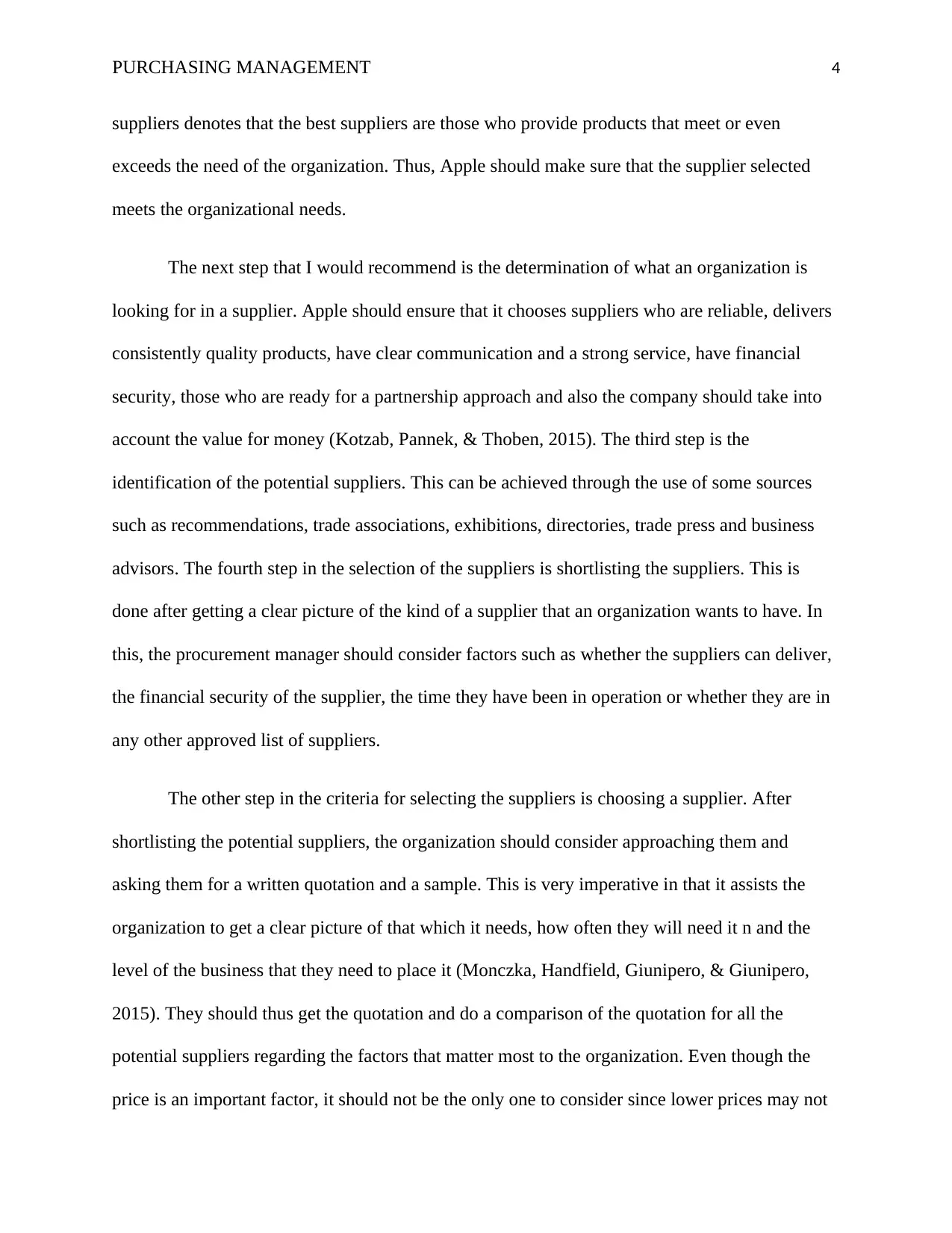
PURCHASING MANAGEMENT 4
suppliers denotes that the best suppliers are those who provide products that meet or even
exceeds the need of the organization. Thus, Apple should make sure that the supplier selected
meets the organizational needs.
The next step that I would recommend is the determination of what an organization is
looking for in a supplier. Apple should ensure that it chooses suppliers who are reliable, delivers
consistently quality products, have clear communication and a strong service, have financial
security, those who are ready for a partnership approach and also the company should take into
account the value for money (Kotzab, Pannek, & Thoben, 2015). The third step is the
identification of the potential suppliers. This can be achieved through the use of some sources
such as recommendations, trade associations, exhibitions, directories, trade press and business
advisors. The fourth step in the selection of the suppliers is shortlisting the suppliers. This is
done after getting a clear picture of the kind of a supplier that an organization wants to have. In
this, the procurement manager should consider factors such as whether the suppliers can deliver,
the financial security of the supplier, the time they have been in operation or whether they are in
any other approved list of suppliers.
The other step in the criteria for selecting the suppliers is choosing a supplier. After
shortlisting the potential suppliers, the organization should consider approaching them and
asking them for a written quotation and a sample. This is very imperative in that it assists the
organization to get a clear picture of that which it needs, how often they will need it n and the
level of the business that they need to place it (Monczka, Handfield, Giunipero, & Giunipero,
2015). They should thus get the quotation and do a comparison of the quotation for all the
potential suppliers regarding the factors that matter most to the organization. Even though the
price is an important factor, it should not be the only one to consider since lower prices may not
suppliers denotes that the best suppliers are those who provide products that meet or even
exceeds the need of the organization. Thus, Apple should make sure that the supplier selected
meets the organizational needs.
The next step that I would recommend is the determination of what an organization is
looking for in a supplier. Apple should ensure that it chooses suppliers who are reliable, delivers
consistently quality products, have clear communication and a strong service, have financial
security, those who are ready for a partnership approach and also the company should take into
account the value for money (Kotzab, Pannek, & Thoben, 2015). The third step is the
identification of the potential suppliers. This can be achieved through the use of some sources
such as recommendations, trade associations, exhibitions, directories, trade press and business
advisors. The fourth step in the selection of the suppliers is shortlisting the suppliers. This is
done after getting a clear picture of the kind of a supplier that an organization wants to have. In
this, the procurement manager should consider factors such as whether the suppliers can deliver,
the financial security of the supplier, the time they have been in operation or whether they are in
any other approved list of suppliers.
The other step in the criteria for selecting the suppliers is choosing a supplier. After
shortlisting the potential suppliers, the organization should consider approaching them and
asking them for a written quotation and a sample. This is very imperative in that it assists the
organization to get a clear picture of that which it needs, how often they will need it n and the
level of the business that they need to place it (Monczka, Handfield, Giunipero, & Giunipero,
2015). They should thus get the quotation and do a comparison of the quotation for all the
potential suppliers regarding the factors that matter most to the organization. Even though the
price is an important factor, it should not be the only one to consider since lower prices may not
Paraphrase This Document
Need a fresh take? Get an instant paraphrase of this document with our AI Paraphraser
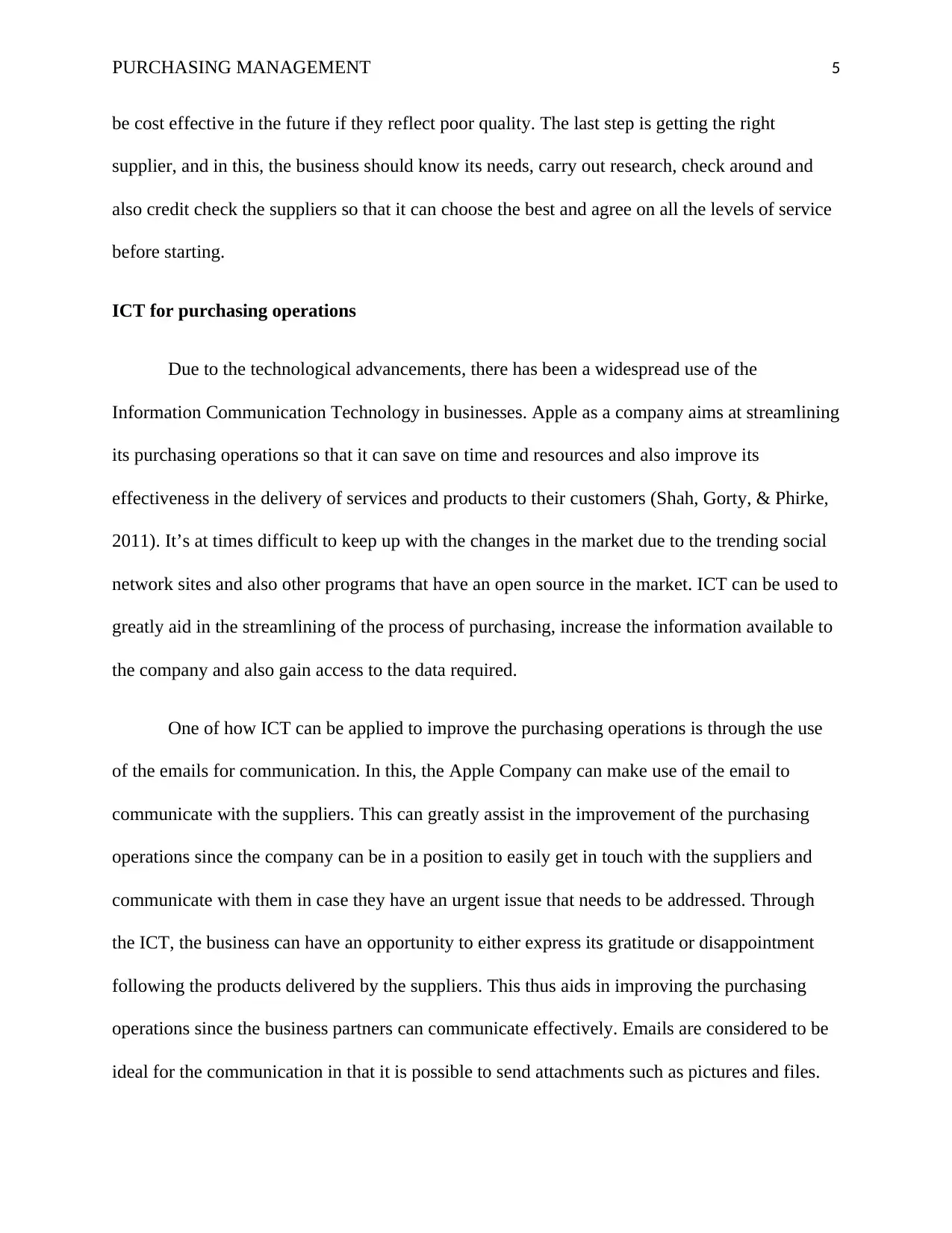
PURCHASING MANAGEMENT 5
be cost effective in the future if they reflect poor quality. The last step is getting the right
supplier, and in this, the business should know its needs, carry out research, check around and
also credit check the suppliers so that it can choose the best and agree on all the levels of service
before starting.
ICT for purchasing operations
Due to the technological advancements, there has been a widespread use of the
Information Communication Technology in businesses. Apple as a company aims at streamlining
its purchasing operations so that it can save on time and resources and also improve its
effectiveness in the delivery of services and products to their customers (Shah, Gorty, & Phirke,
2011). It’s at times difficult to keep up with the changes in the market due to the trending social
network sites and also other programs that have an open source in the market. ICT can be used to
greatly aid in the streamlining of the process of purchasing, increase the information available to
the company and also gain access to the data required.
One of how ICT can be applied to improve the purchasing operations is through the use
of the emails for communication. In this, the Apple Company can make use of the email to
communicate with the suppliers. This can greatly assist in the improvement of the purchasing
operations since the company can be in a position to easily get in touch with the suppliers and
communicate with them in case they have an urgent issue that needs to be addressed. Through
the ICT, the business can have an opportunity to either express its gratitude or disappointment
following the products delivered by the suppliers. This thus aids in improving the purchasing
operations since the business partners can communicate effectively. Emails are considered to be
ideal for the communication in that it is possible to send attachments such as pictures and files.
be cost effective in the future if they reflect poor quality. The last step is getting the right
supplier, and in this, the business should know its needs, carry out research, check around and
also credit check the suppliers so that it can choose the best and agree on all the levels of service
before starting.
ICT for purchasing operations
Due to the technological advancements, there has been a widespread use of the
Information Communication Technology in businesses. Apple as a company aims at streamlining
its purchasing operations so that it can save on time and resources and also improve its
effectiveness in the delivery of services and products to their customers (Shah, Gorty, & Phirke,
2011). It’s at times difficult to keep up with the changes in the market due to the trending social
network sites and also other programs that have an open source in the market. ICT can be used to
greatly aid in the streamlining of the process of purchasing, increase the information available to
the company and also gain access to the data required.
One of how ICT can be applied to improve the purchasing operations is through the use
of the emails for communication. In this, the Apple Company can make use of the email to
communicate with the suppliers. This can greatly assist in the improvement of the purchasing
operations since the company can be in a position to easily get in touch with the suppliers and
communicate with them in case they have an urgent issue that needs to be addressed. Through
the ICT, the business can have an opportunity to either express its gratitude or disappointment
following the products delivered by the suppliers. This thus aids in improving the purchasing
operations since the business partners can communicate effectively. Emails are considered to be
ideal for the communication in that it is possible to send attachments such as pictures and files.
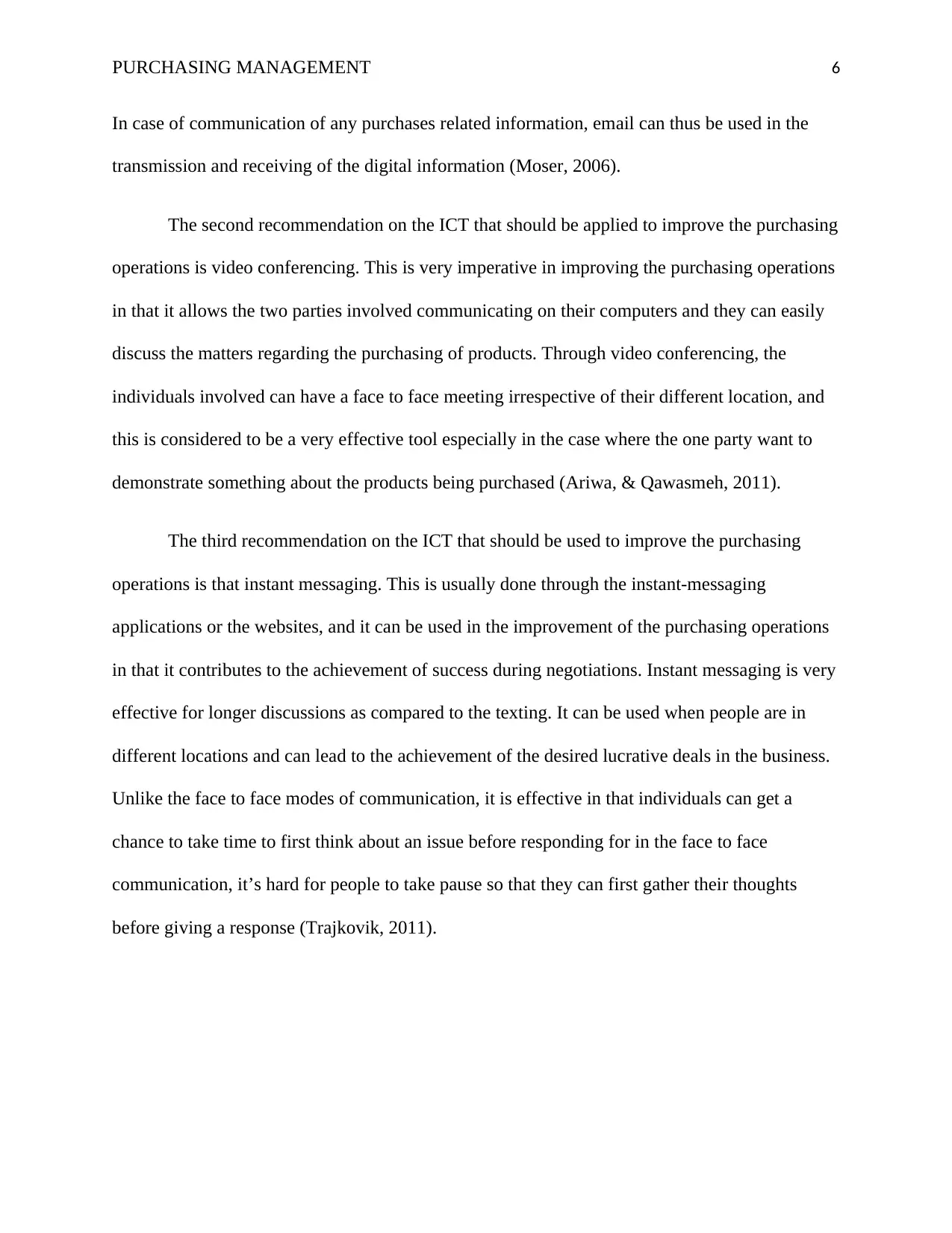
PURCHASING MANAGEMENT 6
In case of communication of any purchases related information, email can thus be used in the
transmission and receiving of the digital information (Moser, 2006).
The second recommendation on the ICT that should be applied to improve the purchasing
operations is video conferencing. This is very imperative in improving the purchasing operations
in that it allows the two parties involved communicating on their computers and they can easily
discuss the matters regarding the purchasing of products. Through video conferencing, the
individuals involved can have a face to face meeting irrespective of their different location, and
this is considered to be a very effective tool especially in the case where the one party want to
demonstrate something about the products being purchased (Ariwa, & Qawasmeh, 2011).
The third recommendation on the ICT that should be used to improve the purchasing
operations is that instant messaging. This is usually done through the instant-messaging
applications or the websites, and it can be used in the improvement of the purchasing operations
in that it contributes to the achievement of success during negotiations. Instant messaging is very
effective for longer discussions as compared to the texting. It can be used when people are in
different locations and can lead to the achievement of the desired lucrative deals in the business.
Unlike the face to face modes of communication, it is effective in that individuals can get a
chance to take time to first think about an issue before responding for in the face to face
communication, it’s hard for people to take pause so that they can first gather their thoughts
before giving a response (Trajkovik, 2011).
In case of communication of any purchases related information, email can thus be used in the
transmission and receiving of the digital information (Moser, 2006).
The second recommendation on the ICT that should be applied to improve the purchasing
operations is video conferencing. This is very imperative in improving the purchasing operations
in that it allows the two parties involved communicating on their computers and they can easily
discuss the matters regarding the purchasing of products. Through video conferencing, the
individuals involved can have a face to face meeting irrespective of their different location, and
this is considered to be a very effective tool especially in the case where the one party want to
demonstrate something about the products being purchased (Ariwa, & Qawasmeh, 2011).
The third recommendation on the ICT that should be used to improve the purchasing
operations is that instant messaging. This is usually done through the instant-messaging
applications or the websites, and it can be used in the improvement of the purchasing operations
in that it contributes to the achievement of success during negotiations. Instant messaging is very
effective for longer discussions as compared to the texting. It can be used when people are in
different locations and can lead to the achievement of the desired lucrative deals in the business.
Unlike the face to face modes of communication, it is effective in that individuals can get a
chance to take time to first think about an issue before responding for in the face to face
communication, it’s hard for people to take pause so that they can first gather their thoughts
before giving a response (Trajkovik, 2011).
⊘ This is a preview!⊘
Do you want full access?
Subscribe today to unlock all pages.

Trusted by 1+ million students worldwide
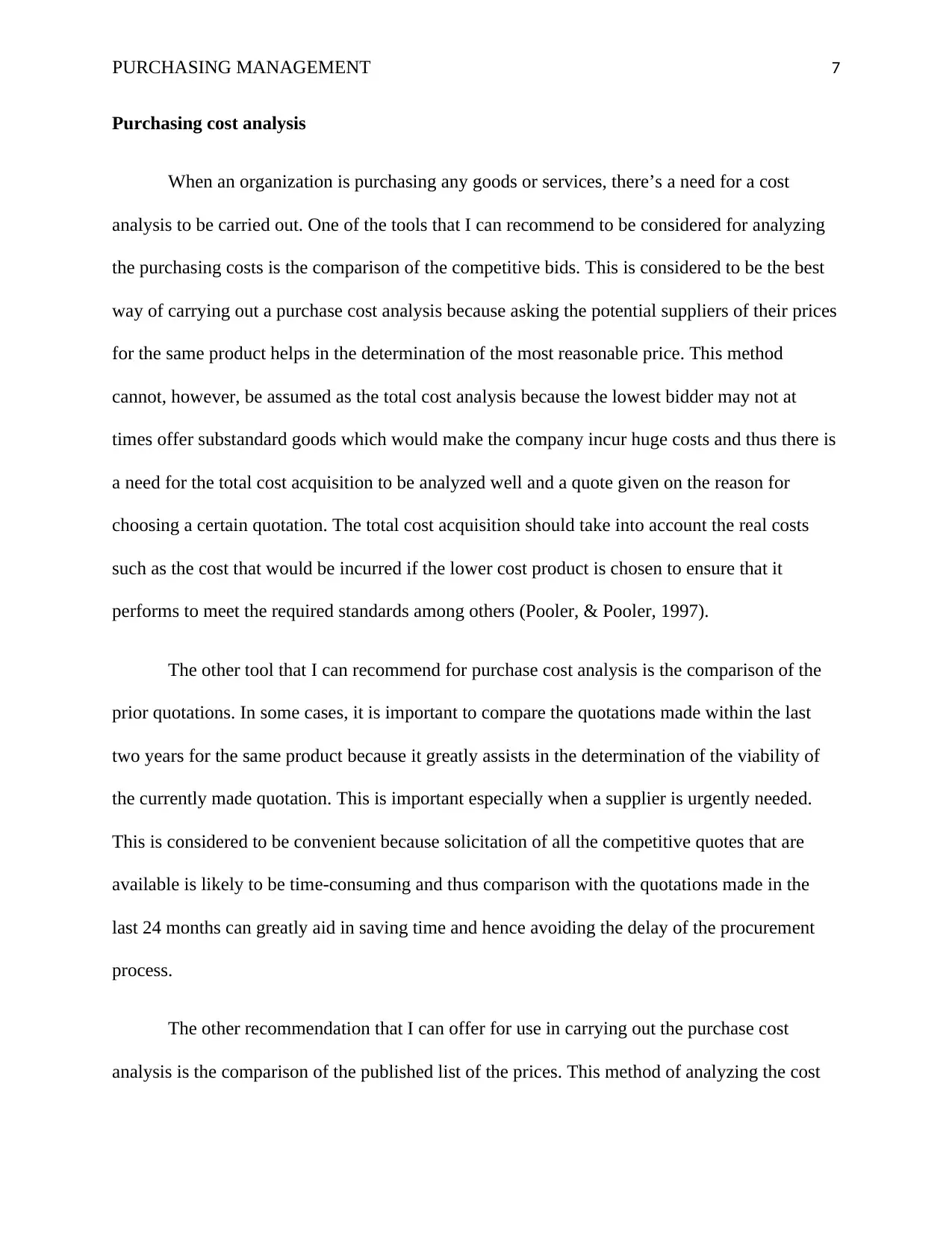
PURCHASING MANAGEMENT 7
Purchasing cost analysis
When an organization is purchasing any goods or services, there’s a need for a cost
analysis to be carried out. One of the tools that I can recommend to be considered for analyzing
the purchasing costs is the comparison of the competitive bids. This is considered to be the best
way of carrying out a purchase cost analysis because asking the potential suppliers of their prices
for the same product helps in the determination of the most reasonable price. This method
cannot, however, be assumed as the total cost analysis because the lowest bidder may not at
times offer substandard goods which would make the company incur huge costs and thus there is
a need for the total cost acquisition to be analyzed well and a quote given on the reason for
choosing a certain quotation. The total cost acquisition should take into account the real costs
such as the cost that would be incurred if the lower cost product is chosen to ensure that it
performs to meet the required standards among others (Pooler, & Pooler, 1997).
The other tool that I can recommend for purchase cost analysis is the comparison of the
prior quotations. In some cases, it is important to compare the quotations made within the last
two years for the same product because it greatly assists in the determination of the viability of
the currently made quotation. This is important especially when a supplier is urgently needed.
This is considered to be convenient because solicitation of all the competitive quotes that are
available is likely to be time-consuming and thus comparison with the quotations made in the
last 24 months can greatly aid in saving time and hence avoiding the delay of the procurement
process.
The other recommendation that I can offer for use in carrying out the purchase cost
analysis is the comparison of the published list of the prices. This method of analyzing the cost
Purchasing cost analysis
When an organization is purchasing any goods or services, there’s a need for a cost
analysis to be carried out. One of the tools that I can recommend to be considered for analyzing
the purchasing costs is the comparison of the competitive bids. This is considered to be the best
way of carrying out a purchase cost analysis because asking the potential suppliers of their prices
for the same product helps in the determination of the most reasonable price. This method
cannot, however, be assumed as the total cost analysis because the lowest bidder may not at
times offer substandard goods which would make the company incur huge costs and thus there is
a need for the total cost acquisition to be analyzed well and a quote given on the reason for
choosing a certain quotation. The total cost acquisition should take into account the real costs
such as the cost that would be incurred if the lower cost product is chosen to ensure that it
performs to meet the required standards among others (Pooler, & Pooler, 1997).
The other tool that I can recommend for purchase cost analysis is the comparison of the
prior quotations. In some cases, it is important to compare the quotations made within the last
two years for the same product because it greatly assists in the determination of the viability of
the currently made quotation. This is important especially when a supplier is urgently needed.
This is considered to be convenient because solicitation of all the competitive quotes that are
available is likely to be time-consuming and thus comparison with the quotations made in the
last 24 months can greatly aid in saving time and hence avoiding the delay of the procurement
process.
The other recommendation that I can offer for use in carrying out the purchase cost
analysis is the comparison of the published list of the prices. This method of analyzing the cost
Paraphrase This Document
Need a fresh take? Get an instant paraphrase of this document with our AI Paraphraser
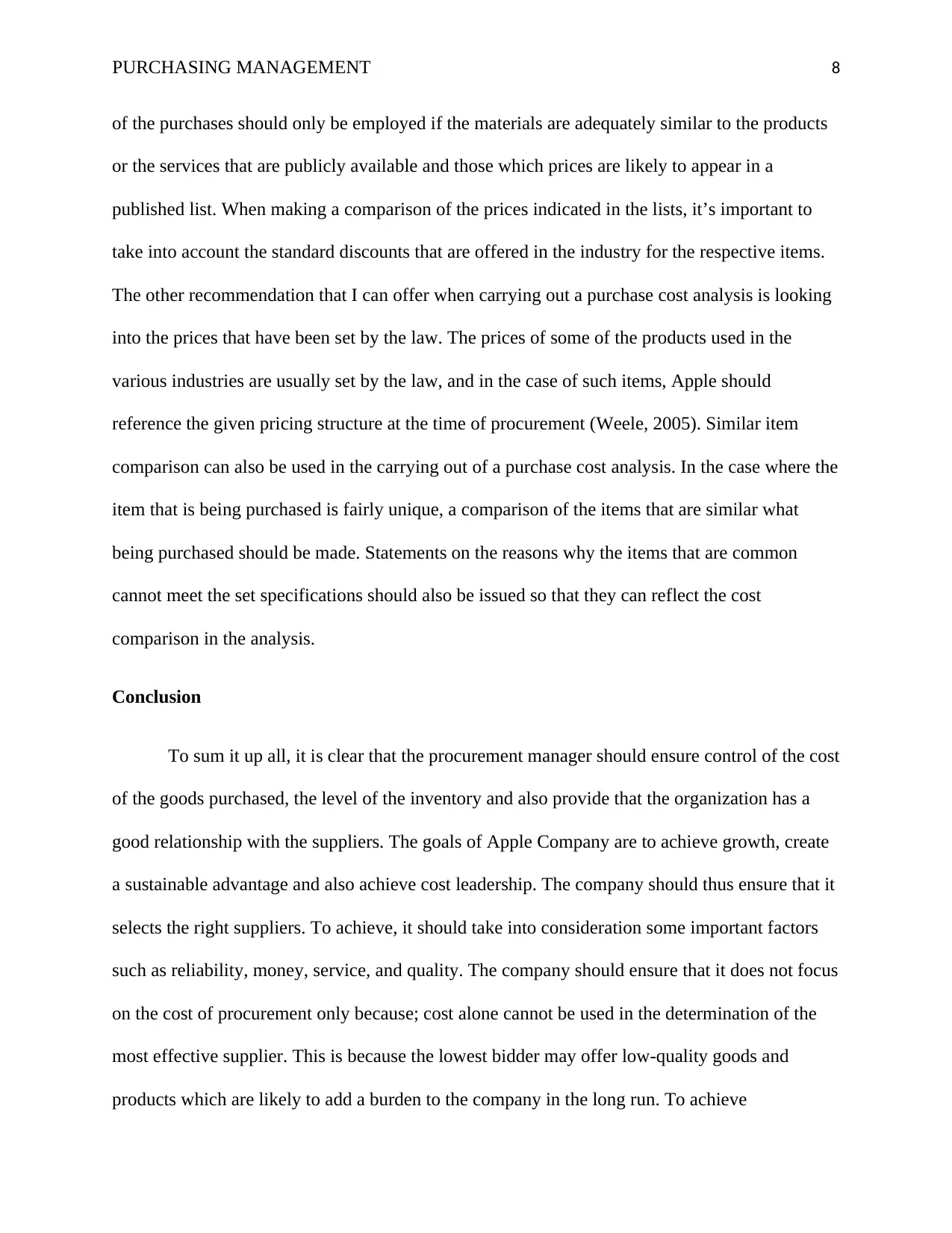
PURCHASING MANAGEMENT 8
of the purchases should only be employed if the materials are adequately similar to the products
or the services that are publicly available and those which prices are likely to appear in a
published list. When making a comparison of the prices indicated in the lists, it’s important to
take into account the standard discounts that are offered in the industry for the respective items.
The other recommendation that I can offer when carrying out a purchase cost analysis is looking
into the prices that have been set by the law. The prices of some of the products used in the
various industries are usually set by the law, and in the case of such items, Apple should
reference the given pricing structure at the time of procurement (Weele, 2005). Similar item
comparison can also be used in the carrying out of a purchase cost analysis. In the case where the
item that is being purchased is fairly unique, a comparison of the items that are similar what
being purchased should be made. Statements on the reasons why the items that are common
cannot meet the set specifications should also be issued so that they can reflect the cost
comparison in the analysis.
Conclusion
To sum it up all, it is clear that the procurement manager should ensure control of the cost
of the goods purchased, the level of the inventory and also provide that the organization has a
good relationship with the suppliers. The goals of Apple Company are to achieve growth, create
a sustainable advantage and also achieve cost leadership. The company should thus ensure that it
selects the right suppliers. To achieve, it should take into consideration some important factors
such as reliability, money, service, and quality. The company should ensure that it does not focus
on the cost of procurement only because; cost alone cannot be used in the determination of the
most effective supplier. This is because the lowest bidder may offer low-quality goods and
products which are likely to add a burden to the company in the long run. To achieve
of the purchases should only be employed if the materials are adequately similar to the products
or the services that are publicly available and those which prices are likely to appear in a
published list. When making a comparison of the prices indicated in the lists, it’s important to
take into account the standard discounts that are offered in the industry for the respective items.
The other recommendation that I can offer when carrying out a purchase cost analysis is looking
into the prices that have been set by the law. The prices of some of the products used in the
various industries are usually set by the law, and in the case of such items, Apple should
reference the given pricing structure at the time of procurement (Weele, 2005). Similar item
comparison can also be used in the carrying out of a purchase cost analysis. In the case where the
item that is being purchased is fairly unique, a comparison of the items that are similar what
being purchased should be made. Statements on the reasons why the items that are common
cannot meet the set specifications should also be issued so that they can reflect the cost
comparison in the analysis.
Conclusion
To sum it up all, it is clear that the procurement manager should ensure control of the cost
of the goods purchased, the level of the inventory and also provide that the organization has a
good relationship with the suppliers. The goals of Apple Company are to achieve growth, create
a sustainable advantage and also achieve cost leadership. The company should thus ensure that it
selects the right suppliers. To achieve, it should take into consideration some important factors
such as reliability, money, service, and quality. The company should ensure that it does not focus
on the cost of procurement only because; cost alone cannot be used in the determination of the
most effective supplier. This is because the lowest bidder may offer low-quality goods and
products which are likely to add a burden to the company in the long run. To achieve
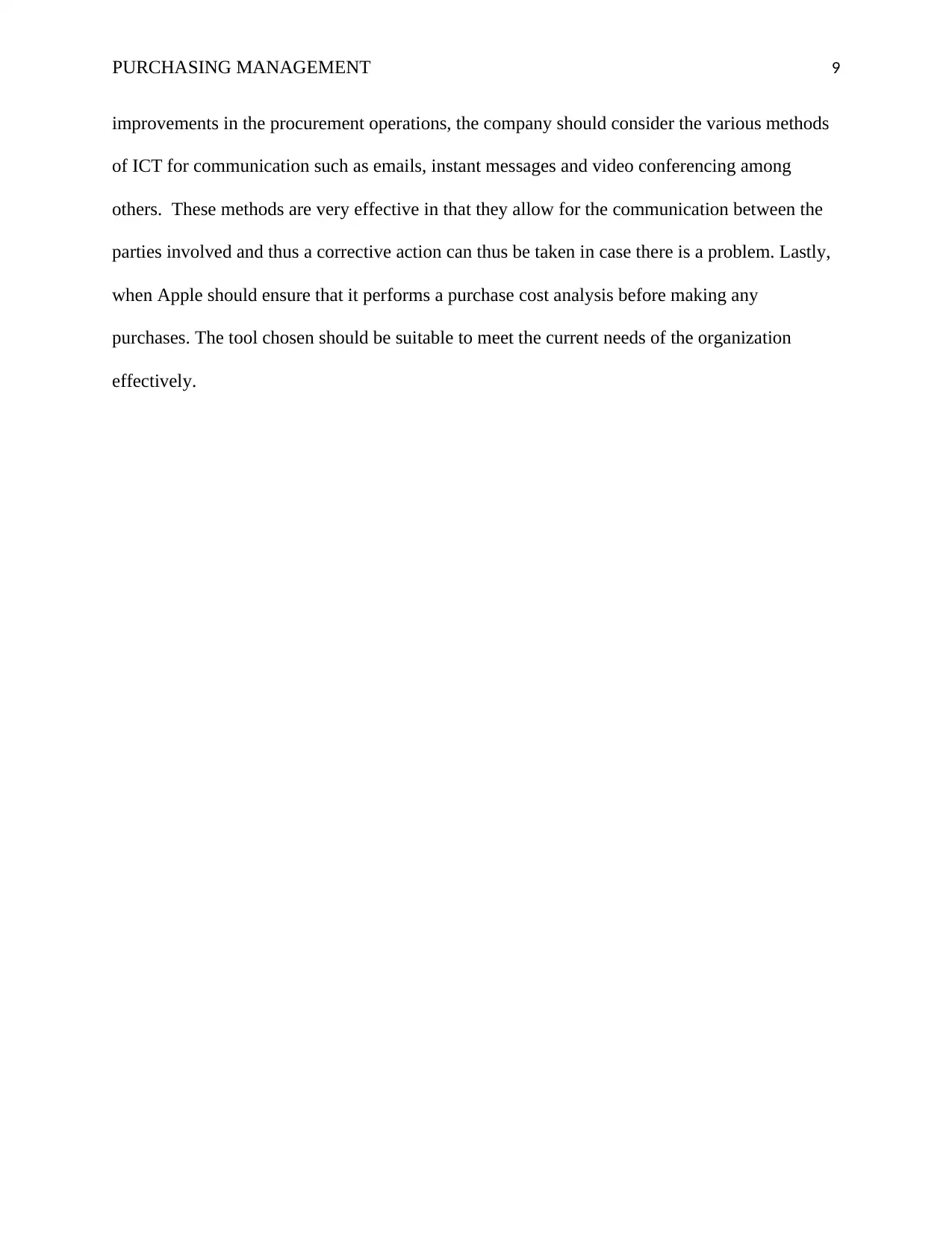
PURCHASING MANAGEMENT 9
improvements in the procurement operations, the company should consider the various methods
of ICT for communication such as emails, instant messages and video conferencing among
others. These methods are very effective in that they allow for the communication between the
parties involved and thus a corrective action can thus be taken in case there is a problem. Lastly,
when Apple should ensure that it performs a purchase cost analysis before making any
purchases. The tool chosen should be suitable to meet the current needs of the organization
effectively.
improvements in the procurement operations, the company should consider the various methods
of ICT for communication such as emails, instant messages and video conferencing among
others. These methods are very effective in that they allow for the communication between the
parties involved and thus a corrective action can thus be taken in case there is a problem. Lastly,
when Apple should ensure that it performs a purchase cost analysis before making any
purchases. The tool chosen should be suitable to meet the current needs of the organization
effectively.
⊘ This is a preview!⊘
Do you want full access?
Subscribe today to unlock all pages.

Trusted by 1+ million students worldwide
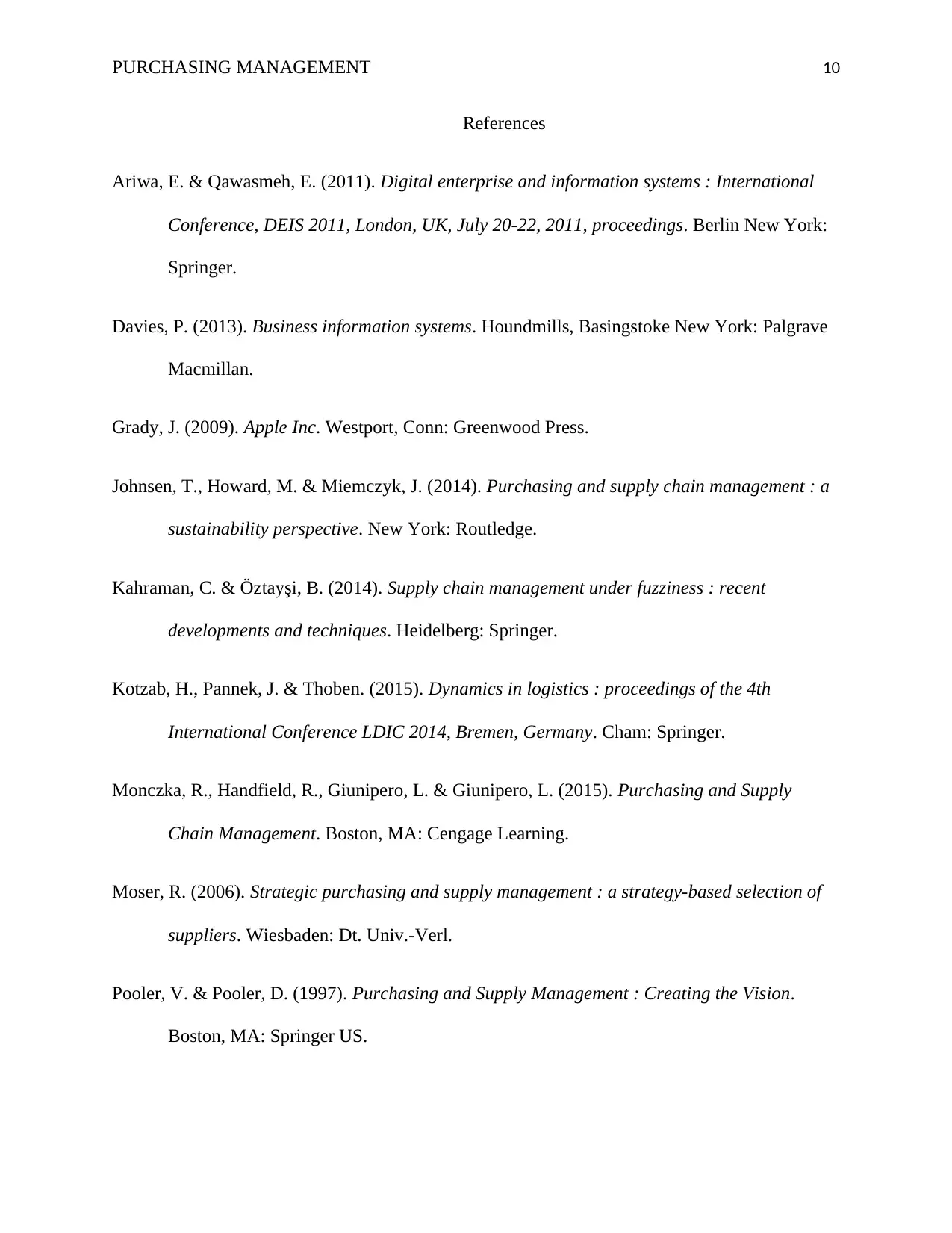
PURCHASING MANAGEMENT 10
References
Ariwa, E. & Qawasmeh, E. (2011). Digital enterprise and information systems : International
Conference, DEIS 2011, London, UK, July 20-22, 2011, proceedings. Berlin New York:
Springer.
Davies, P. (2013). Business information systems. Houndmills, Basingstoke New York: Palgrave
Macmillan.
Grady, J. (2009). Apple Inc. Westport, Conn: Greenwood Press.
Johnsen, T., Howard, M. & Miemczyk, J. (2014). Purchasing and supply chain management : a
sustainability perspective. New York: Routledge.
Kahraman, C. & Ö ztayşi, B. (2014). Supply chain management under fuzziness : recent
developments and techniques. Heidelberg: Springer.
Kotzab, H., Pannek, J. & Thoben. (2015). Dynamics in logistics : proceedings of the 4th
International Conference LDIC 2014, Bremen, Germany. Cham: Springer.
Monczka, R., Handfield, R., Giunipero, L. & Giunipero, L. (2015). Purchasing and Supply
Chain Management. Boston, MA: Cengage Learning.
Moser, R. (2006). Strategic purchasing and supply management : a strategy-based selection of
suppliers. Wiesbaden: Dt. Univ.-Verl.
Pooler, V. & Pooler, D. (1997). Purchasing and Supply Management : Creating the Vision.
Boston, MA: Springer US.
References
Ariwa, E. & Qawasmeh, E. (2011). Digital enterprise and information systems : International
Conference, DEIS 2011, London, UK, July 20-22, 2011, proceedings. Berlin New York:
Springer.
Davies, P. (2013). Business information systems. Houndmills, Basingstoke New York: Palgrave
Macmillan.
Grady, J. (2009). Apple Inc. Westport, Conn: Greenwood Press.
Johnsen, T., Howard, M. & Miemczyk, J. (2014). Purchasing and supply chain management : a
sustainability perspective. New York: Routledge.
Kahraman, C. & Ö ztayşi, B. (2014). Supply chain management under fuzziness : recent
developments and techniques. Heidelberg: Springer.
Kotzab, H., Pannek, J. & Thoben. (2015). Dynamics in logistics : proceedings of the 4th
International Conference LDIC 2014, Bremen, Germany. Cham: Springer.
Monczka, R., Handfield, R., Giunipero, L. & Giunipero, L. (2015). Purchasing and Supply
Chain Management. Boston, MA: Cengage Learning.
Moser, R. (2006). Strategic purchasing and supply management : a strategy-based selection of
suppliers. Wiesbaden: Dt. Univ.-Verl.
Pooler, V. & Pooler, D. (1997). Purchasing and Supply Management : Creating the Vision.
Boston, MA: Springer US.
Paraphrase This Document
Need a fresh take? Get an instant paraphrase of this document with our AI Paraphraser
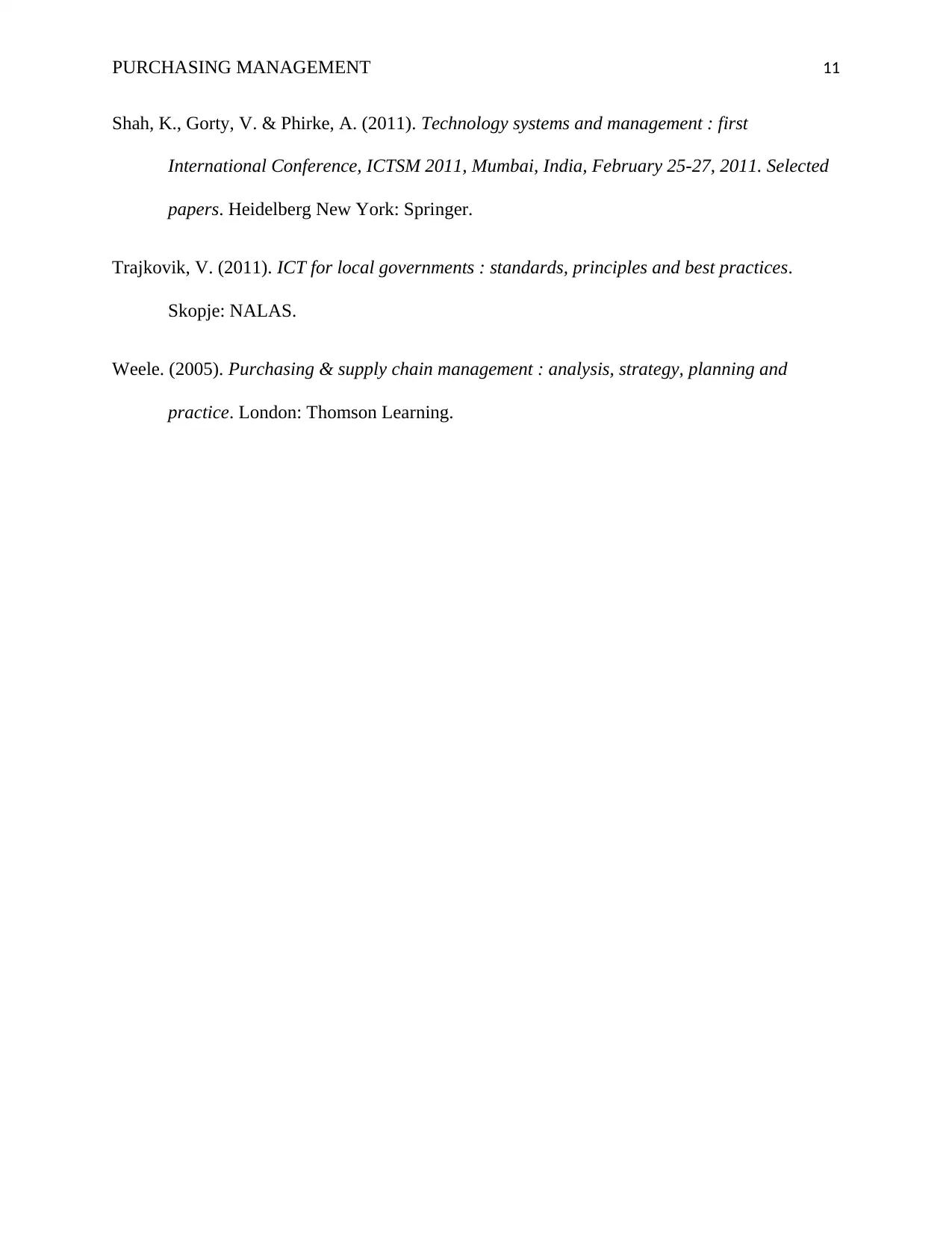
PURCHASING MANAGEMENT 11
Shah, K., Gorty, V. & Phirke, A. (2011). Technology systems and management : first
International Conference, ICTSM 2011, Mumbai, India, February 25-27, 2011. Selected
papers. Heidelberg New York: Springer.
Trajkovik, V. (2011). ICT for local governments : standards, principles and best practices.
Skopje: NALAS.
Weele. (2005). Purchasing & supply chain management : analysis, strategy, planning and
practice. London: Thomson Learning.
Shah, K., Gorty, V. & Phirke, A. (2011). Technology systems and management : first
International Conference, ICTSM 2011, Mumbai, India, February 25-27, 2011. Selected
papers. Heidelberg New York: Springer.
Trajkovik, V. (2011). ICT for local governments : standards, principles and best practices.
Skopje: NALAS.
Weele. (2005). Purchasing & supply chain management : analysis, strategy, planning and
practice. London: Thomson Learning.
1 out of 11
Related Documents
Your All-in-One AI-Powered Toolkit for Academic Success.
+13062052269
info@desklib.com
Available 24*7 on WhatsApp / Email
![[object Object]](/_next/static/media/star-bottom.7253800d.svg)
Unlock your academic potential
Copyright © 2020–2025 A2Z Services. All Rights Reserved. Developed and managed by ZUCOL.




